Land-Use Transition of Tourist Villages in the Metropolitan Suburbs and Its Driving Forces: A Case Study of She Village in Nanjing City, China
Abstract
1. Introduction
2. Analysis of Land-Use Transition in Tourist Villages in the Suburbs
2.1. Division of Transformation Stages and Characteristics of Land-Use Morphology of Tourist Villages in the Suburbs
2.2. The Driving Forces of Land-Use Transition in Tourism Villages
3. Materials and Methods
3.1. Study Area
3.2. Date Sources
3.3. Methods
4. Results
4.1. Land-Use Transition of She Village
4.1.1. Dominant Morphology of Land-Use Transition in She Village
4.1.2. Recessive Morphology of Land-Use Transition in She Village
4.2. Driving Forces of Land-Use Transition in She Village
4.2.1. Main Driving Forces of Each Stage
4.2.2. Changes in the Impact Intensity of Driving Forces
5. Discussion
5.1. Problems in the Process of Land-Use Transformation in She Village
5.2. Implications of Suburban Land-Use Transformation for Rural Transformation
5.3. Research Shortage
6. Conclusions
Author Contributions
Funding
Data Availability Statement
Acknowledgments
Conflicts of Interest
References
- Hoggart, K.; Paniagua, A. What rural restructuring? J. Rural Stud. 2001, 17, 41–62. [Google Scholar] [CrossRef]
- Liu, S.; Wang, Y. From Native Rural China to Urban-rural China: The Rural Transition Perspective of China Transformation. Manag. World 2018, 34, 128–146. [Google Scholar] [CrossRef]
- Tu, S.; Long, H.; Zhang, Y.; Ge, D.; Qu, Y. Rural restructuring at village level under rapid urbanization in metropolitan suburbs of China and its implications for innovations in land use policy. Habitat Int. 2018, 77, 143–152. [Google Scholar] [CrossRef]
- Lange, A.; Piorr, A.; Siebert, R.; Zasada, I. Spatial differentiation of farm diversification: How rural attractiveness and vicinity to cities determine farm households’ response to the CAP. Land Use Policy 2013, 31, 136–144. [Google Scholar] [CrossRef]
- Holmes, J. Impulses towards a multifunctional transition in rural Australia: Gaps in the research agenda. J. Rural Stud. 2006, 22, 142–160. [Google Scholar] [CrossRef]
- Jia, K.; Qiao, W.; Chai, Y.; Feng, T.; Wang, Y.; Ge, D. Spatial distribution characteristics of rural settlements under diversified rural production functions: A case of Taizhou, China. Habitat Int. 2020, 102, 102201. [Google Scholar] [CrossRef]
- Yansui, L.; Long, H.; Chen, Y.; Wang, J.; Li, Y.; Li, Y.; Yang, Y.; Zhou, Y. Progress of research on urban-rural transformation and rural development in China in the past decade and future prospects. J. Geogr. Sci. 2016, 26, 1117–1132. [Google Scholar] [CrossRef]
- Meyfroidt, P.; Chowdhury, R.R.; de Bremond, A.; Ellis, E.C.; Erb, K.-H.; Filatova, T.; Garrett, R.D.; Grove, J.; Heinimann, A.; Kuemmerle, T.; et al. Middle-range theories of land system change. Glob. Environ. Chang. 2018, 53, 52–67. [Google Scholar] [CrossRef]
- Long, H.; Zou, J.; Pykett, J.; Li, Y. Analysis of rural transformation development in China since the turn of the new millennium. Appl. Geogr. 2011, 31, 1094–1105. [Google Scholar] [CrossRef]
- Ma, W.; Jiang, G.; Wang, D.; Li, W.; Guo, H.; Zheng, Q. Rural settlements transition (RST) in a suburban area of metropolis: Internal structure perspectives. Sci. Total Environ. 2018, 615, 672–680. [Google Scholar] [CrossRef]
- Long, H.; Qu, Y. Land use transitions and land management: A mutual feedback perspective. Land Use Policy 2018, 74, 111–120. [Google Scholar] [CrossRef]
- Ge, D.; Wang, Z.; Tu, S.; Long, H.; Yan, H.; Sun, D.; Qiao, W. Coupling analysis of greenhouse-led farmland transition and rural transformation development in China’s traditional farming area: A case of Qingzhou City. Land Use Policy 2019, 86, 113–125. [Google Scholar] [CrossRef]
- Long, H.; Ge, D.; Wang, J. Progress and Prospects of the Coupling Research on Land Use Transitions and Rural Transformation Development. Acta Geogr. Sin. 2019, 74, 2547–2559. [Google Scholar] [CrossRef]
- Su, K.; Yang, Q.; Zhang, B.; Zhang, Z. The Coupling Mechanism between Rural Land Use Transition and Small-scale Peasant Economy Change in Mountainous Areas. Geogr. Res. 2019, 38, 399–413. [Google Scholar] [CrossRef]
- Long, H.; Tu, S. Land Use Transition and Rural Vitalization. China Land Sci. 2018, 32, 1–6. [Google Scholar] [CrossRef]
- Ge, D.; Zhou, G.; Qiao, W.; Yang, M. Land use transition and rural spatial governance: Mechanism, framework and perspectives. J. Geogr. Sci. 2020, 30, 1325–1340. [Google Scholar] [CrossRef]
- Zhang, B.; Sun, P.; Jiang, G.; Zhang, R.; Gao, J. Rural land use transition of mountainous areas and policy implications for land consolidation in China. J. Geogr. Sci. 2019, 29, 1713–1730. [Google Scholar] [CrossRef]
- Yang, R. Spatial Differentiation and Mechanisms of Typical Rural Areas in the Suburbs of a Metropolis: A Case Study of Beicun Village, Baiyun District, Guangzhou. Acta Geogr. Sin. 2019, 74, 1622–1636. [Google Scholar] [CrossRef]
- Tu, S.; Long, H.; Zhang, Y.; Zhou, X. Process and Driving Factors of Rural Restructuring in Typical Villages. Acta Geogr. Sin. 2019, 74, 125–141. [Google Scholar] [CrossRef]
- Jiang, K.; Liu, Z.; Li, Y.; Wang, Y.; Wang, Y. Land use change of typical villages in the loess hilly and gully region and implications for regional rural transformation and development. Prog. Geogr. 2019, 38, 1305–1315. [Google Scholar] [CrossRef]
- Liu, Y.; Long, H. Land use transitions and their dynamic mechanism: The case of the Huang-Huai-Hai Plain. J. Geogr. Sci. 2016, 26, 515–530. [Google Scholar] [CrossRef]
- Xi, J.; Zhao, M.; Ge, Q.; Kong, Q. Changes in Land Use of a Village Driven by over 25 Years of Tourism: The Case of Gougezhuang village, China. Land Use Policy 2014, 10, 119–130. [Google Scholar] [CrossRef]
- Zhu, L.; Li, L.; Liu, S.; Li, Y. The evolution of village land use function in the metropolitan suburbs and its inspiration to rural revitalization: A Case Study of Jiangjiayan Village in Chengdu City. Geogr. Res. 2019, 38, 535–549. [Google Scholar] [CrossRef]
- Li, B.; Zhou, X.; Liu, P.; Chen, C.; Liu, Y. Function Transformation and Spatial Reconstructuring of Zhangguying Village in Urbanization. Sci. Geogr. Sin. 2018, 38, 1310–1318. [Google Scholar] [CrossRef]
- Zou, L.; Liu, Y.; Yang, J.; Yang, S.; Wang, Y.; Zhi, C.; Hu, X. Quantitative identification and spatial analysis of land use ecological-production-living functions in rural areas on China’s southeast coast. Habitat Int. 2020, 100, 102182. [Google Scholar] [CrossRef]
- Chen, Y.; Zhou, J. The Evolution Process and Spatial Layout Patterns of Land Use in Urban Fringe Areas. Urban Plan. Overseas 1998, 2, 10–16. [Google Scholar]
- Chen, Y.; Wu, W. An Analysis on the Man-land System and its Dynamics in Urban-rural Interlocking Belt. Sci. Geogr. Sin. 1998, 18, 418–424. [Google Scholar]
- Lapola, D.M.; Martinelli, L.A.; Peres, C.A.; Ometto, J.P.H.B.; Ferreira, M.E.; Nobre, C.A.; Aguiar, A.P.D.; Bustamante, M.M.C.; Cardoso, M.F.; Costa, M.H.; et al. Pervasive transition of the Brazilian land-use system. Nat. Clim. Chang. 2014, 4, 27–35. [Google Scholar] [CrossRef]
- Liang, X.; Jin, X.; Ren, J.; Gu, Z.; Zhou, Y. A research framework of land use transition in Suzhou City coupled with land use structure and landscape multifunctionality. Sci. Total Environ. 2020, 737, 139932. [Google Scholar] [CrossRef] [PubMed]
- Luo, Y.; Zhou, C.S. The Review and Outlook on Urban-rural Fringe Studies in China. Urban Stud. 2005, 12, 25–30. [Google Scholar]
- Hu, S.; Tong, L.; Long, H. Land Use Transition Potential and its Assessment Framework. Geogr. Res. 2019, 38, 1367–1377. [Google Scholar] [CrossRef]
- Zhu, H.; Li, X. Discussion on the Index Method of Regional Land Use Change. Acta Geogr. Sin. 2003, 58, 643–650. [Google Scholar]
- Zhu, D. Methods for Detecting Land Use Changes Based on the Land Use Transition Matrix. Resour. Sci. 2010, 32, 1544–1550. [Google Scholar]
- Liu, S.; Wu, C.; Shen, H. A GIS based model of urban land use growth in Beijing. Acta Geogr. Sin. 2002, 55, 407–416. [Google Scholar]
- Yang, N.; Long, H.; Liu, Y.; Zhang, Y. Research Progress and Prospect of Rural Transformation and Reconstruction in China: Paradigms and Main Content. Prog. Geogr. 2015, 34, 1019–1030. [Google Scholar] [CrossRef][Green Version]
- Ristic, D.; Vukoicic, D.; Milincic, M. Tourism and Sustainable Development of Rural Settlements in Protected Areas Example NP Kopaonik (Serbia). Land Use Policy 2019, 89, 104231. [Google Scholar] [CrossRef]
- Tao, H.; Huang, Z.; Ran, F. Rural Tourism Spatial Reconstruction Model from the Perspective of ATV: A Case Study of Mufu Township, Hubei Province, China. Sustainability 2018, 10, 2675. [Google Scholar] [CrossRef]
- Yao, G.; Xie, H. Rural spatial restructuring in ecologically fragile mountainous areas of southern China: A case study of Changgang Town, Jiangxi Province. J. Rural. Stud. 2016, 47, 435–448. [Google Scholar] [CrossRef]
- Zhang, J.; Jiang, K.F. Analyzing Capital Logic Behind Rural Construction Boom in Contemporary China. Mod. City Stud. 2016, 31, 2–8. [Google Scholar]
- Tian, J.; Wang, B.; Cheng, L.; Wang, S. The Process and Mechanism of Regional Land Use Transition Guided by Policy: A Case Study of Northeast China. Geogr. Res. 2020, 39, 805–821. [Google Scholar] [CrossRef]
- Zhou, Y.; Li, X.; Liu, Y. Rural land system reforms in China: History, issues, measures and prospects. Land Use Policy 2020, 91, 104330. [Google Scholar] [CrossRef]
- Ge, D.; Long, H.; Zhang, Y.; Ma, L.; Li, T. Farmland transition and its influences on grain production in China. Land Use Policy 2018, 70, 94–105. [Google Scholar] [CrossRef]
- Ge, D.; Long, H.; Qiao, W.; Wang, Z.; Sun, D.; Yang, R. Effects of rural–urban migration on agricultural transformation: A case of Yucheng City, China. J. Rural Stud. 2020, 76, 85–95. [Google Scholar] [CrossRef]
- He, T.; Qiao, W.; Jia, K.; Chai, Y.; Hu, Y.; Sun, P.; Wang, Y.; Feng, T. Selecting Rural Development Paths Based on Village Multifunction: A Case of Jingjiang City, China. Complexity 2020, 2020, 1–15. [Google Scholar] [CrossRef]
- Huang, J. Rural Revitalization: Rural Transformation, Structural Transformation and Government’s Functions. Issues Agric. Econ. 2020, 481, 4–16. [Google Scholar] [CrossRef]
- Zasada, I. Multifunctional peri-urban agriculture—A review of societal demands and the provision of goods and services by farming. Land Use Policy 2011, 28, 639–648. [Google Scholar] [CrossRef]
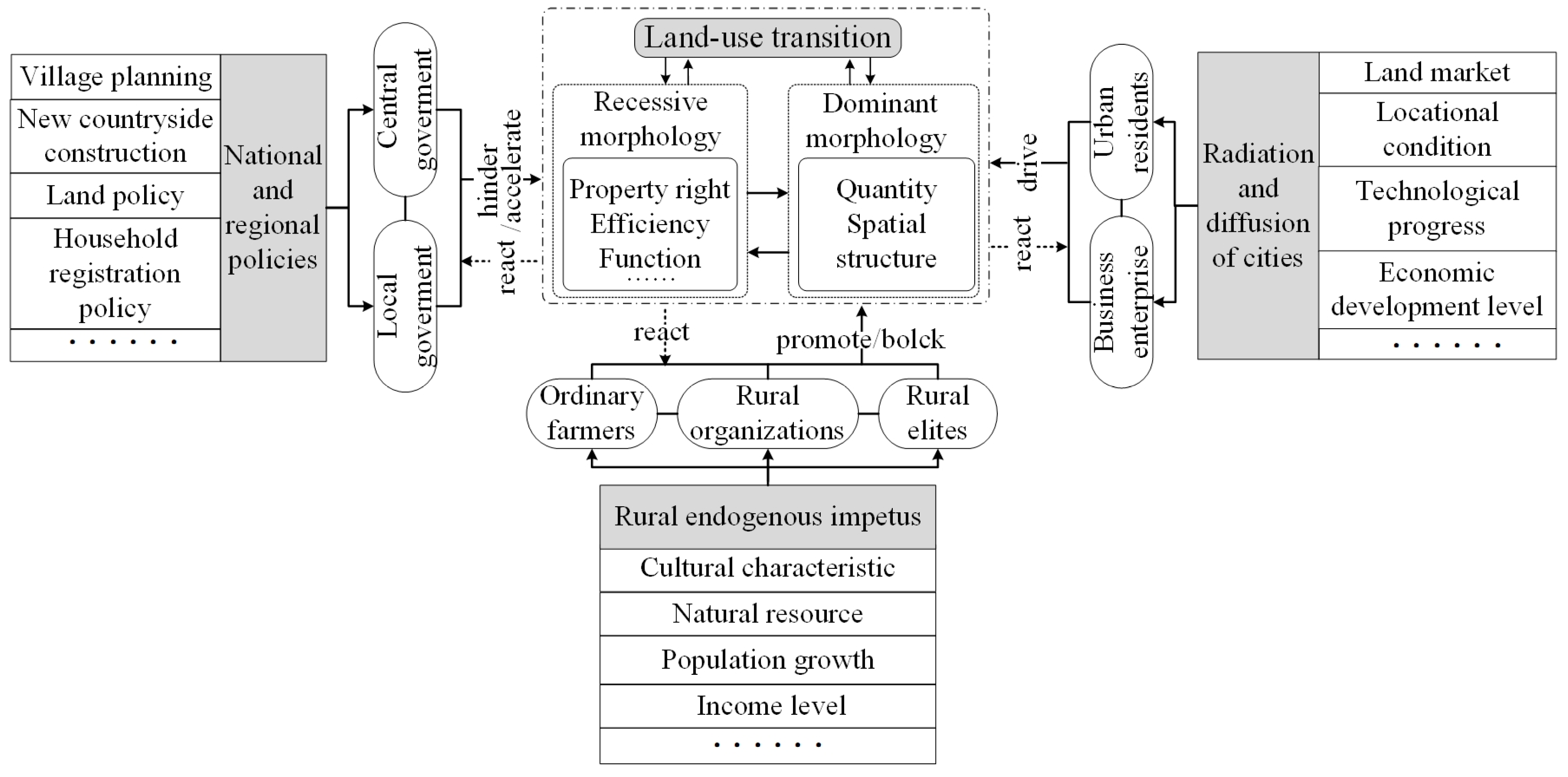
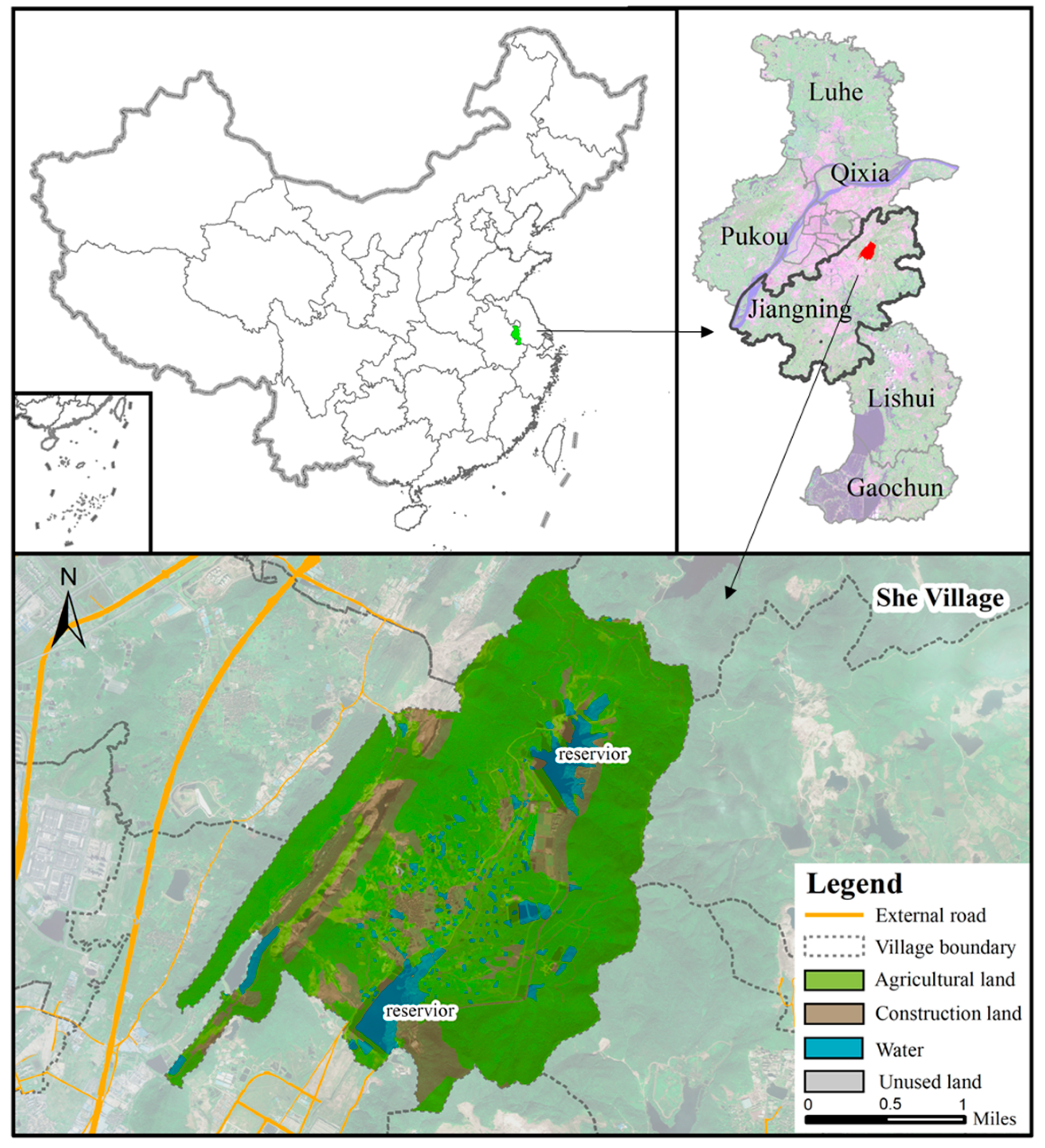
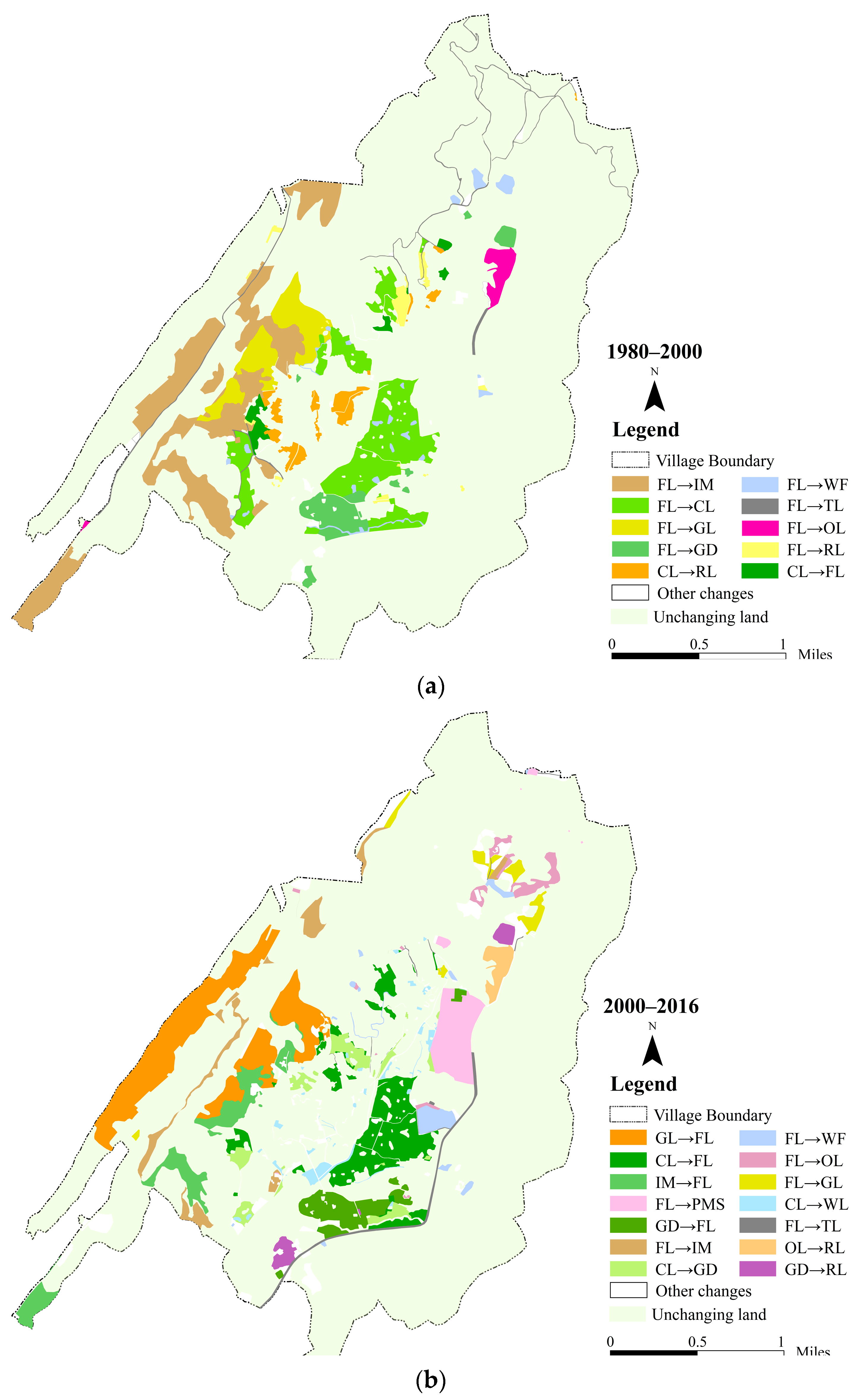
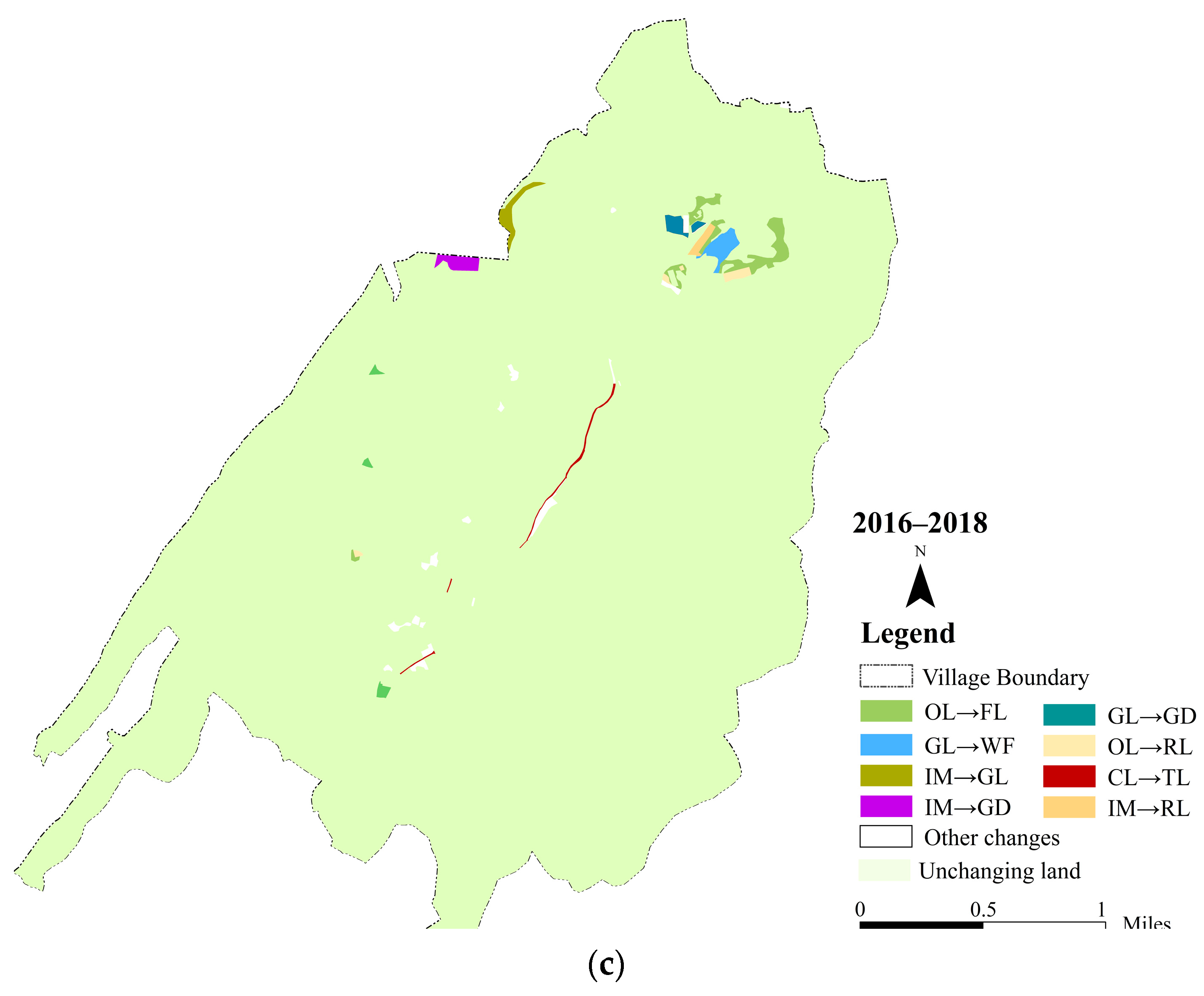
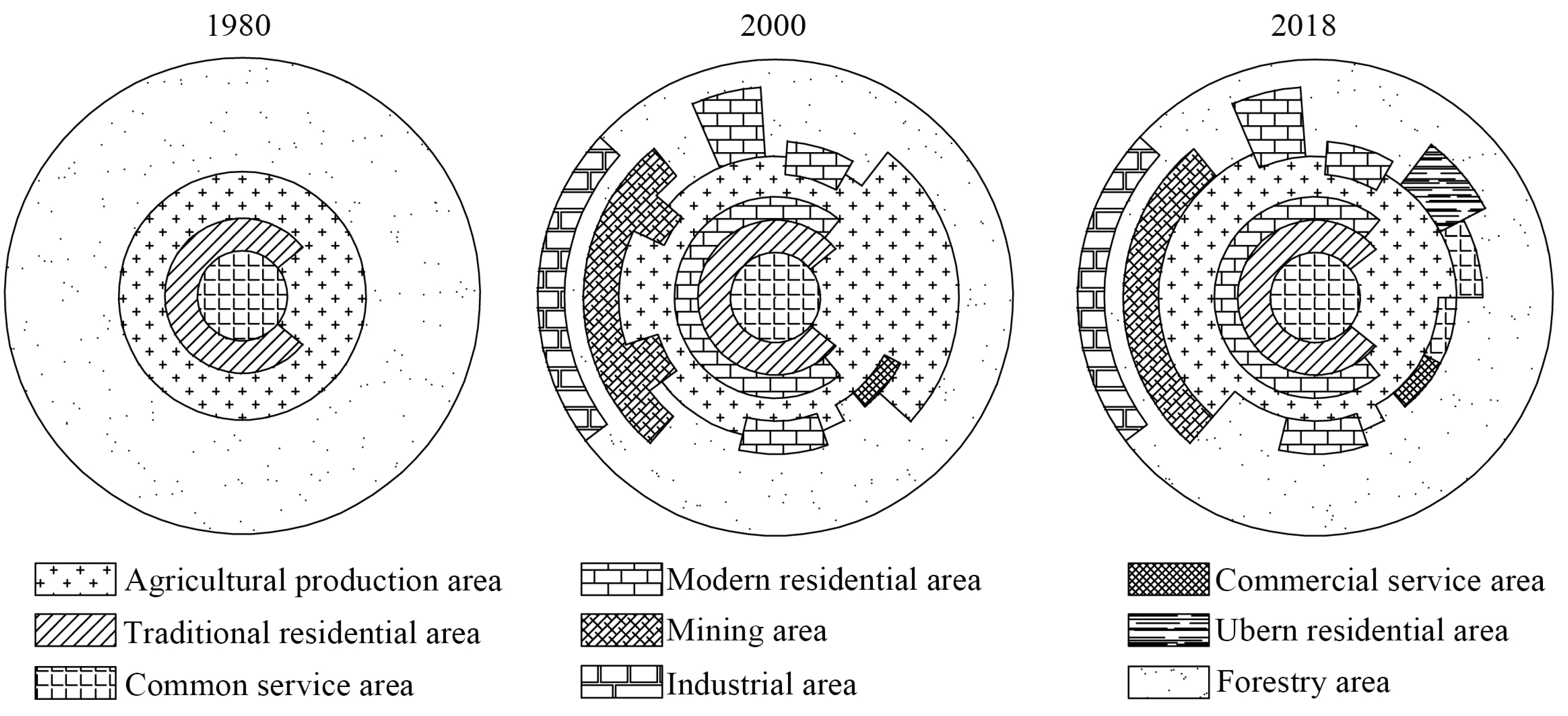
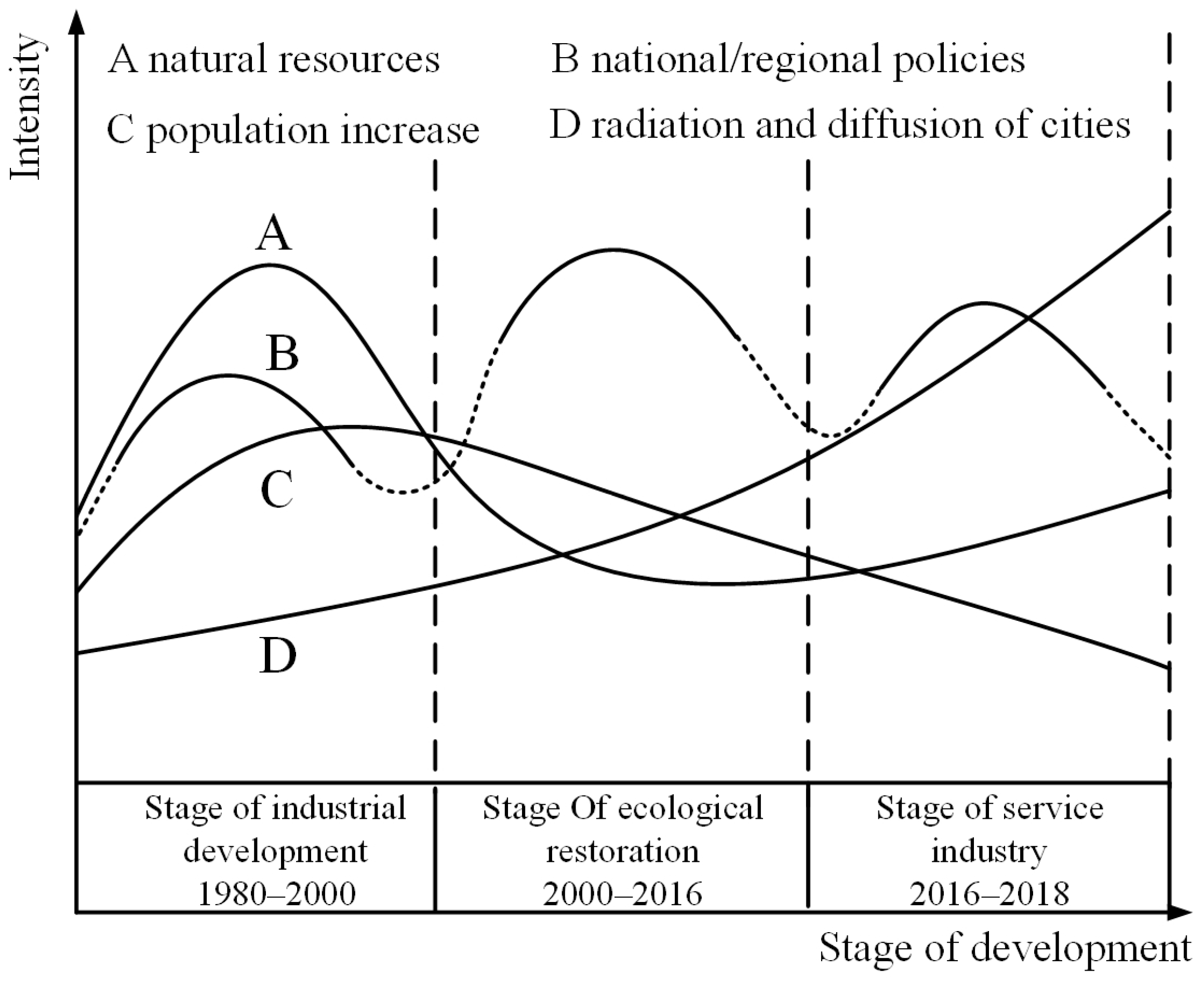
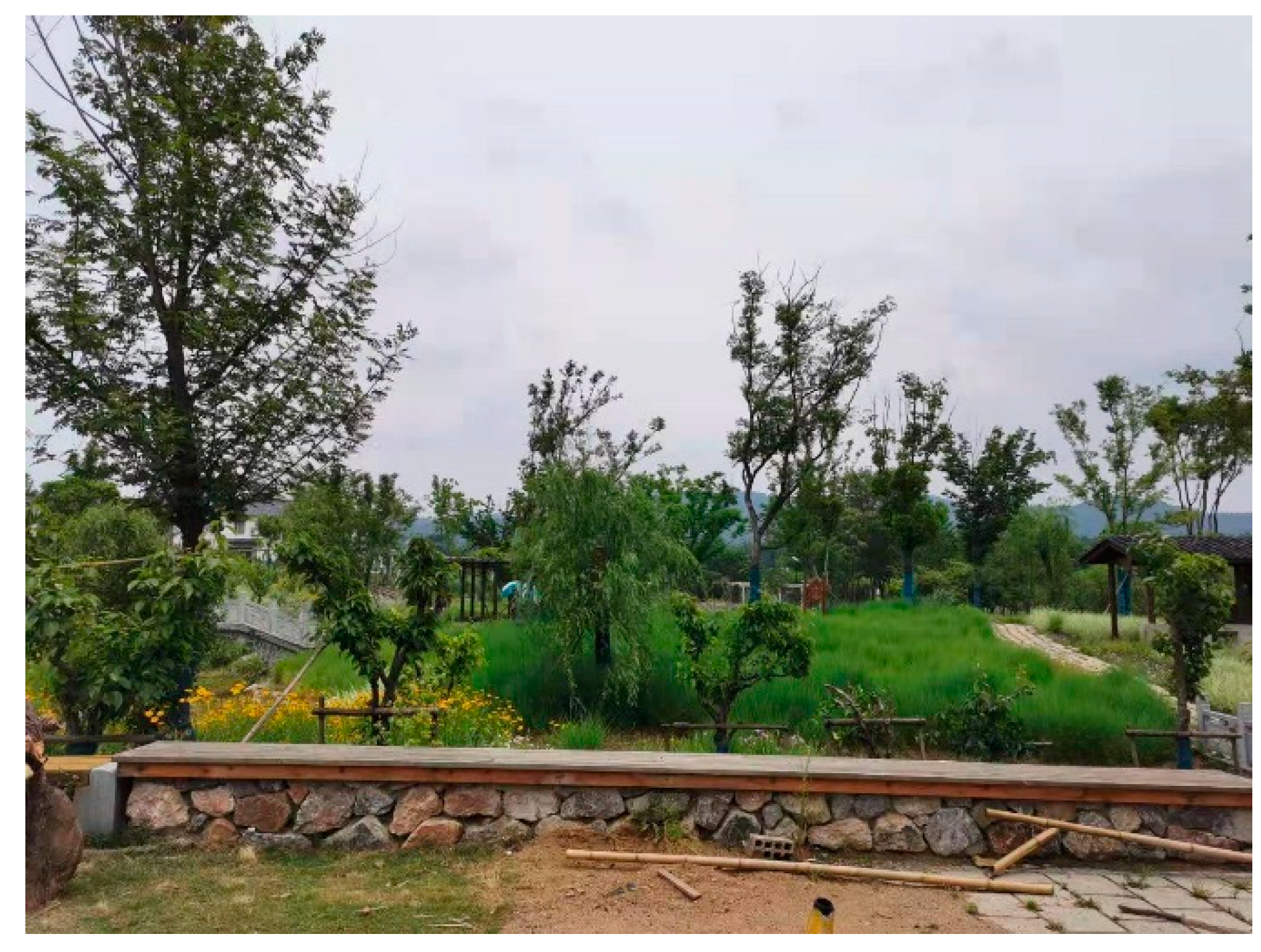
| Land-Use Type | 1980 | 2000 | 2016 | 2018 | ||||
|---|---|---|---|---|---|---|---|---|
| Area/hm2 | Percent | Area/hm2 | Percent | Area/hm2 | Percent | Area/hm2 | Percent | |
| CL | 118.40 | 6.62% | 176.85 | 10.34% | 86.69 | 5.07% | 85.27 | 4.94% |
| FL | 1359.81 | 75.99% | 1062.98 | 62.18% | 1156.63 | 67.66% | 1164.43 | 67.40% |
| GD | 17.52 | 0.98% | 43.36 | 2.54% | 37.92 | 2.22% | 40.53 | 2.35% |
| GL | 55.98 | 3.13% | 93.31 | 5.46% | 16.61 | 0.97% | 14.18 | 0.82% |
| RL | 10.98 | 0.61% | 36.43 | 2.13% | 61.69 | 3.61% | 64.84 | 3.75% |
| IM | 32.11 | 1.79% | 152.53 | 8.92% | 131.04 | 7.67% | 123.99 | 7.18% |
| CSF | 1.06 | 0.06% | 3.29 | 0.19% | 13.58 | 0.79% | 14.19 | 0.82% |
| PMS | 0.54 | 0.03% | 1.51 | 0.09% | 31.37 | 1.83% | 32.30 | 1.87% |
| TL | 9.68 | 0.54% | 20.30 | 1.19% | 34.60 | 2.02% | 36.70 | 2.12% |
| WL | 96.03 | 5.37% | 108.45 | 6.34% | 126.91 | 7.42% | 130.52 | 7.56% |
| OL | 7.41 | 0.41% | 10.52 | 0.62% | 12.49 | 0.73% | 2.57 | 0.15% |
| Land-Use Type | CL | FL | GD | GL | RL | IM | CSF | PMS | TL | WL | OL | |
|---|---|---|---|---|---|---|---|---|---|---|---|---|
| 1980–2000 | ATI | 85.44 | 10.46 | 26.30 | 37.32 | 25.45 | 120.41 | 2.22 | 0.96 | 10.62 | 13.41 | 9.05 |
| ATO | 26.99 | 307.29 | 0.46 | 0 | 0 | 0 | 0 | 0 | 0 | 0.99 | 5.94 | |
| TC | 112.42 | 317.75 | 26.77 | 37.32 | 25.45 | 120.41 | 2.22 | 0.96 | 10.62 | 14.40 | 14.99 | |
| NC | 58.45 | 296.82 | 25.84 | 37.32 | 25.45 | 120.41 | 2.22 | 0.96 | 10.62 | 12.42 | 3.11 | |
| SC | 53.97 | 20.93 | 0.92 | 0 | 0 | 0 | 0 | 0 | 0 | 1.98 | 11.88 | |
| 2000–2016 | ATI | 2.83 | 206.11 | 28.07 | 16.06 | 25.91 | 22.06 | 10.60 | 29.86 | 14.94 | 21.08 | 12.05 |
| ATO | 92.99 | 112.47 | 33.51 | 92.76 | 0.65 | 149.55 | 0.31 | 0 | 0.64 | 2.63 | 10.07 | |
| TC | 95.82 | 318.59 | 61.58 | 108.81 | 26.56 | 171.62 | 10.91 | 29.86 | 15.58 | 23.71 | 22.13 | |
| NC | 90.16 | 93.64 | 5.44 | 76.70 | 25.26 | 127.49 | 10.30 | 29.86 | 14.29 | 18.45 | 1.98 | |
| SC | 5.66 | 224.95 | 56.14 | 32.11 | 1.29 | 44.13 | 0.61 | 0 | 1.29 | 5.26 | 20.15 | |
| 2016–2018 | ATI | 1.84 | 9.24 | 4.08 | 2.38 | 3.64 | 0.03 | 0.61 | 0.94 | 2.09 | 3.64 | 0 |
| ATO | 3.26 | 1.43 | 1.47 | 4.81 | 0.49 | 7.0 | 0 | 0 | 0 | 0 | 9.93 | |
| TC | 5.10 | 10.67 | 5.55 | 7.19 | 4.13 | 7.10 | 0.61 | 0.94 | 2.09 | 3.64 | 9.93 | |
| NC | 1.42 | 7.81 | 2.61 | 2.43 | 3.16 | 7.04 | 0.61 | 0.94 | 2.09 | 3.64 | 9.93 | |
| SC | 3.68 | 2.87 | 2.94 | 4.76 | 0.98 | 0.06 | 0 | 0 | 0 | 0 | 0 | |
| Stages | Expansion Area (m2) | Expansion Intensity (%) |
|---|---|---|
| 1980–2000 | 159.68 | 46.70% |
| 2000–2016 | 103.38 | 37.79% |
| 2016–2018 | 7.31 | 21.38% |
Publisher’s Note: MDPI stays neutral with regard to jurisdictional claims in published maps and institutional affiliations. |
© 2021 by the authors. Licensee MDPI, Basel, Switzerland. This article is an open access article distributed under the terms and conditions of the Creative Commons Attribution (CC BY) license (http://creativecommons.org/licenses/by/4.0/).
Share and Cite
Chai, Y.; Qiao, W.; Hu, Y.; He, T.; Jia, K.; Feng, T.; Wang, Y. Land-Use Transition of Tourist Villages in the Metropolitan Suburbs and Its Driving Forces: A Case Study of She Village in Nanjing City, China. Land 2021, 10, 168. https://doi.org/10.3390/land10020168
Chai Y, Qiao W, Hu Y, He T, Jia K, Feng T, Wang Y. Land-Use Transition of Tourist Villages in the Metropolitan Suburbs and Its Driving Forces: A Case Study of She Village in Nanjing City, China. Land. 2021; 10(2):168. https://doi.org/10.3390/land10020168
Chicago/Turabian StyleChai, Yibei, Weifeng Qiao, Yi Hu, Tianqi He, Kaiyang Jia, Ting Feng, and Yahua Wang. 2021. "Land-Use Transition of Tourist Villages in the Metropolitan Suburbs and Its Driving Forces: A Case Study of She Village in Nanjing City, China" Land 10, no. 2: 168. https://doi.org/10.3390/land10020168
APA StyleChai, Y., Qiao, W., Hu, Y., He, T., Jia, K., Feng, T., & Wang, Y. (2021). Land-Use Transition of Tourist Villages in the Metropolitan Suburbs and Its Driving Forces: A Case Study of She Village in Nanjing City, China. Land, 10(2), 168. https://doi.org/10.3390/land10020168






